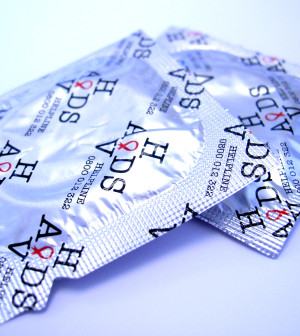- Skip Storing This Everyday Product in the Fridge Door
- Green Tea + B3 Pairing May Boost Brain Health
- Navigating Your Midlife Crisis: Embracing New Possibilities
- City Raccoons Showing Signs of Domestication
- Mapping the Exposome: Science Broadens Focus to Environmental Disease Triggers
- One Week Less on Social Media Linked to Better Mental Health
- Your Brain Changes in Stages as You Age, Study Finds
- Some Suicide Victims Show No Typical Warning Signs, Study Finds
- ByHeart Formula Faces Lawsuits After Babies Sickened With Botulism
- Switch to Vegan Diet Could Cut Your Greenhouse Gas Emissions in Half
Black Americans Still Undertreated for HIV

Although progress has been made, blacks in America are still being hit harder by HIV/AIDS, a new report from the U.S. Centers for Disease Control and Prevention says.
The CDC study found that of more than 12,200 black men and women diagnosed with HIV in 2014, nearly 22 percent had progressed to AIDS by the time they were diagnosed. That means diagnosis and treatment is often coming too late.
Moreover, among all black Americans with HIV in 2013, only about 54 percent were receiving continuous medical care. Of those getting care, less than half had effectively suppressed the virus. This is far below the National HIV/AIDS Strategy goals of 90 percent of HIV patients in treatment and 80 percent with undetectable HIV by 2020, the study authors noted.
“While we have made great progress in HIV prevention among African Americans in recent years, it is clear that we need to increase the proportion of African Americans living with HIV who are aware of their status and are receiving treatment,” said lead researcher Andre Dailey. He’s an epidemiologist in the CDC’s division of HIV/AIDS prevention.
According to the report, from 2010 to 2014, the annual HIV diagnosis rate decreased for blacks by 16 percent.
Yet, in 2015, black people still accounted for 45 percent of new HIV diagnoses. Among black women, the annual rate of HIV diagnosis was about 16 times greater than the rate among white women, the CDC reported.
The findings also indicated that many black men may be infected with HIV for years without knowing it, Dailey said.
“Newly diagnosed HIV-positive persons who start treatment immediately live longer, healthier lives and dramatically reduce their risk of passing the virus to another person,” he noted.
The results of the analysis underscore the importance of directing prevention and care efforts to populations that are most affected by HIV, Dailey added.
“CDC is pursuing an approach that focuses resources on programs and initiatives that can have the biggest impact,” he said. “This includes targeted focus on African Americans and in geographic areas of greatest need — including the South.”
For people living with HIV, getting diagnosed and starting treatment early is an essential first step toward long-term health, Dailey explained.
“Increasing HIV testing in health-care and non-health-care settings can improve the proportion of African Americans who know their status and ultimately drive down HIV infection in the black community,” he said.
For the study, Dailey and his colleagues used data from the National HIV Surveillance System in 33 areas around the nation.
The report was published Feb. 3 in the CDC’s Morbidity and Mortality Weekly Report (MMWR).
Greg Millett is vice president and director of public policy at amfAR, The Foundation for AIDS Research. He said, “The good news is that HIV diagnosis has been decreasing all over the United States over the last 10 years, and it’s also decreasing among African Americans.”
Millett said that “this shows that prevention efforts are working, as well as efforts to increase HIV treatment in the African-American community.”
The bad news is that blacks fare poorly on HIV outcomes and access to care compared with white Americans and others, he said.
“This is not something that’s specific to HIV. There are other diseases where blacks are more likely to die or have worse outcomes than other groups,” Millett added.
“It’s really more symptomatic of marginalization in society — issues of poverty, not having access to health insurance, and homelessness, which is associated with not taking HIV medications and not having the virus suppressed,” he said.
More access to care — particularly in rural areas — is needed, he said.
“The other good news is that we are seeing a decrease in HIV diagnoses among African-American women as well as a decrease in disparities between African-American women and other women,” Millett said.
A second report in the same issue of the MMWR looks at this reduction and shows that HIV has significantly decreased among black women in the United States. From 2005 to 2014, HIV infection rates among black women dropped 42 percent, according to the researchers.
But in 2015, black women still accounted for almost two-thirds of women living with HIV in the United States.
These findings are more evidence that, although progress has been made, disparities in the prevalence of HIV still exist between black and white women, according to Donna McCree and colleagues at the CDC’s division of HIV/AIDS prevention.
More information
For more information on HIV/AIDS, visit the U.S. Centers for Disease Control and Prevention.
Source: HealthDay
Copyright © 2025 HealthDay. All rights reserved.










